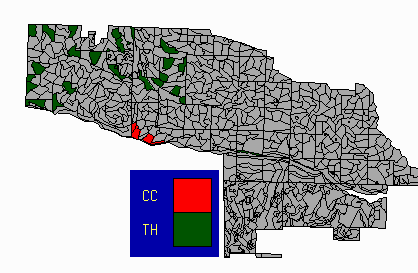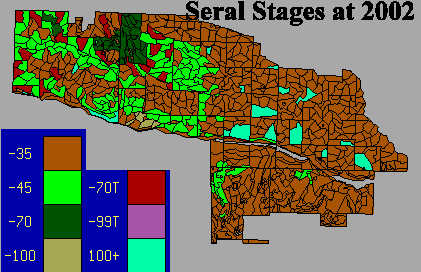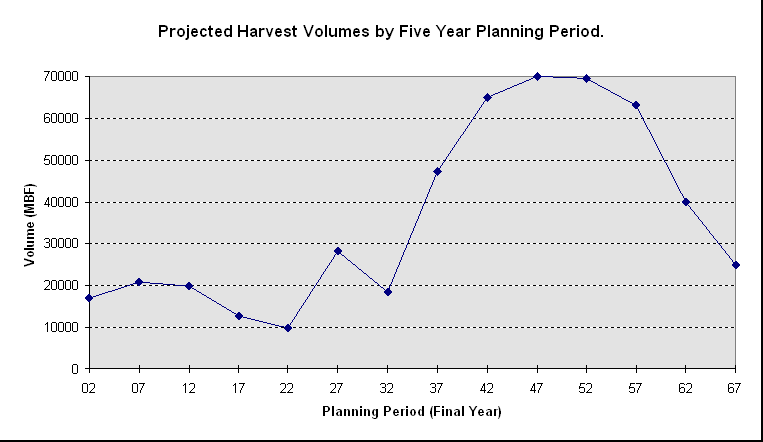
Chapter 3 SILVICULTURE AND HARVEST YIELD PROJECTIONS
This chapter will provide a description of the growth and yield processes that were used to determine possible future harvest volumes for the Toutle Unit. It will also discuss what those projected harvest levels are, and explore the implications of these harvest levels for the Toutle Unit and the SW region. This analysis and the recommendations contained in this report are as extensive as allowed by the existing data, but further analysis may provide a higher level of detail once FRIS data becomes available for this unit.
3.1 DNR Goals for the Toutle Unit
The DNR’s primary silvicultural goal for the Toutle unit is sustained production of twenty million board feet of timber for each five year planning period. This goal is tempered by the goals of remaining within the DNR’s HCP that will be implemented in 1998, and remaining within the Forest Practices Act. All of these goals should be viewed within the context of the main goal of the DNR as a whole, maximizing return to the beneficiary.
3.2 Growth Modeling Process
Growth modeling for the Toutle Unit was done using the Forest Service’s Forest Vegetation Simulator (FVS). Specifically, the West Cascade variant (FVS-WC) was used. The purpose of using this model was to determine rates of growth (in merchantable board feet, expressed as an interest rate) to be entered into SNAP.
3.2.1 Forest Inventory Issues
FVS provides the most accurate modeling of stand growth when it is provided with a stand table, essentially a tree list including diameters, ages, heights, species, and volumes. As this data was not available for the Toutle Unit, FVS was used to simulate the growth of an "average" stand given stand conditions such as site index, elevation, aspect, and latitude. Another constraint on the FVS modeling was the inclusion of non-standard site index species in the vegetation data. In particular, the use of Western Hemlock and "NC" for non-commercial as the site index species forced abnormal growth rates from FVS. In order to work around this, all growth projections were done to a standard site index of Douglas-fir 110.
3.2.2 "Average" Silvicultural Regime
Due to limitations imposed by SNAP regarding the number of species growth rates that can be entered, all Douglas-fir and Noble Fir stands were modeled as growing at the same rates and as having the same silvicultural prescriptions. This prescription called for planting the stand at 462 trees per acre (a 10’ by 10’ spacing), thinning pre-commercially at 10 years to 180, thinning commercially at 35 years to 100 trees per acre, and harvesting at 70 years or greater. A second silvicultural prescription was modeled in FVS that did not include the pre-commercial thinning prior to harvest.
3.2.3 Growth Outputs
The growth outputs derived from FVS largely consisted of tables of merchantable volume for each ten year period. These tables were used to derive a periodic rate of growth for SNAP. At this point it was observed that FVS-WC was failing to accurately model mortality after thinning. Although the thinning prescriptions, when checked on the Drew & Flewelling density management diagram for Douglas-fir, indicated that the stand should not experience significant mortality for a number of years, FVS applied a near constant rate of mortality throughout the stands from planting to harvest. It is hypothesized that this is either a program error in FVS, or that it is a result of the small number of West Cascades plots that the Forest Service used for projection in FVS.
Table 3.1 FVS Growth Outputs per Ten Year Period, Thinned and Unthinned.

3.3 Snap Analysis
The primary goals in the SNAP analysis were to determine what harvest volumes were possible over the next rotation, where these volumes would originate, and which roads would be used to bring the volume out. All of these items are standard SNAP outputs that are derived from vegetation and road network GIS covers with the addition of FVS derived growth values.
3.3.1 SNAP Inputs
The primary SNAP inputs are the vegetation and transportation covers for the Toutle Unit. These covers are modified, however, to provide for harvest polygons smaller than 100 acres, and to provide a road node designation for the harvest volume originating in each polygon. The growth rates derived from FVS, together with the average silvicultural prescription, harvest costs, mill values of the wood, and length of projection are entered directly into the SNAP program.
3.3.2 SNAP Processes and Constraints
SNAP attempts to maximize the value of the wood delivered to the mill location by minimizing the road construction and haul cost associated with the harvest used within a number of user defined constraints. The constraints used in this analysis included limiting the size of any one harvest opening to 100 acres, providing for five years of green up before adjacent polygons can be harvested, excluding all stands older than 100 years from harvest, and complying with HCP stream buffering regulations.
Other constraints were used that are artifacts of the data that was available, rather than a reflection of the silvicultural treatments that are acceptable. Among these constraints, we were required to assume that all volume in the stand was contained in the main species. We also excluded from harvest any stands not primarily Douglas-fir or Noble Fir, as the volumes produced would grossly overstate reality. Initial stand volumes for stands under 40 years were also set to constant levels reflecting the FVS predicted values for these periods. The reason for this reassignment of initial values was the inordinately high values that some stands had for this item which would result in tremendous rates of growth over the rotation.
3.3.3 SNAP and Growth Rates
The most notable failure of the SNAP program is the inability of the program to accurately apply the FVS derived growth rate that is supplied for it. Although this growth rate is supplied in the form of an interest rate, as it is requested in the SNAP manual, the resulting volumes at various times in the projection fail to match those predicted by the FVS model. The correction for this is to manually adjust the growth rates in SNAP over a repeated number of runs until the resulting volumes are appropriate for the age of the stand, given the FVS output.
3.4 SNAP Results
This chapter will only discuss SNAP results in the contexts of harvest volumes, silvicultural treatments over time, and seral stages produced over time. Any SNAP results regarding road segments or the road network will be discussed in subsequent chapters.
3.4.1 Silvicultural Treatments Over Time
The general progression of silvicultural treatments is described in the table following this paragraph. In general, it is following the pattern of timber maturation as it passes West to East through the Toutle Unit. The patterns for the first two periods are displayed in the map below, while all patterns are included in Appendix A.
Table 3.2 General Pattern of Silvicultural Treatments.
|
1997 to 2017 |
Thinning - West End |
|
2017 to 2027 |
Thinning - East End |
|
2027 to 2047 |
Clear Cuts - West End |
|
2047 to 2057 |
Clear Cuts - Dispersed |
|
2057 to 2067 |
Clear Cuts - East End |
Note that acreage values for thinning and clear cutting were unavailable as outputs from SNAP. This is because we were unable to make the SNAP program replant cleared land, and had to retain a portion of the previous stand to supply volume for SNAP’s growth function. As a result of this, SNAP identified all polygons as being partially harvested, and none as being clear cut.

Figure 3.1 Silvicultural Treatments in Period 1.

Figure 3.2 Silvicultural Treatments in Period 2.
Note that the merchantable timber stands near the South Fork are harvested in the first two periods, with the specific combination of stands dictated by adjacency requirements. As there are no adjacency requirements on thinnings, the thinned stands are distributed in order to capture all available thinning volume.
3.4.2 Seral Stage Distribution
The seral stages currently present in the forest can be grouped into three general types. These types are stands currently available for thinning, stands too young for thinning, and stands greater than 100 years in age. Although there are some stands that are currently eligible for harvest, they are a relatively small component of the landscape. These groupings are fairly well clumped in their spatial distribution. Stands currently available for thinning are present largely in the Western half of the unit, while stands too young for thinning are dominant in the Eastern half.
The distribution of these stands will change over time. The clumping currently present in the landscape will be dispersed by adjacency requirements at the time of harvest. Further, towards the end of the rotation, younger stands will be more predominant in the Western than the Eastern half.
Table 3.3 Key to Seral Stage Distribution Figures.
|
-35 |
Stands younger than 35 years. |
|
-45 |
Stands between 35 and 45, eligible for thinning. |
|
-70 |
Stands between 45 and 70, unthinned. |
|
-100 |
Stands between 70 and 100, unthinned, eligible for harvest. |
|
-70T |
Stands between 40 and 70, thinned. |
|
-99T |
Stands between 70 and 100, thinned, available for harvest. |
|
100+ |
Stands, thinned or unthinned, over 100 years and unavailable for harvest. |

Figure 3.3 Seral Stage Distribution in 2002.

Figure 3.4 Seral Stage Distribution in 2007
Seral stage distribution diagrams are included for all periods in Appendix B.
3.4.3 Projected Harvest Volumes
Harvest volumes will vary from a low of roughly 10MMBF to a high of almost 70MMBF over the course of the next rotation (Figure 3.5). This distribution of the timber flow is largely dictated by the age classes of wood that are presently in the unit, although the adjacency requirements also influence the volume of wood that can be removed in any one period. In the analysis no upper harvest volume limit was set, the only constraints related to a five-year adjacency requirment.
 Figure 3.5 Projected harvest volumes by five year planning period, expressed in thousands of board feet. Represents volume from clear cut and thinning activities.
Figure 3.5 Projected harvest volumes by five year planning period, expressed in thousands of board feet. Represents volume from clear cut and thinning activities.

Figure 3.6 Harvest Volume from Clear Cutting by Five Year Period.

Figure 3.7 Harvest Volumes from Thinning by Five Year Period.
3.5 Implications of SNAP Results and Recommendations
3.5.1 Implications of SNAP Results
As the graph of timber volumes demonstrates, between 2012 and approximately 2025, timber volumes will fall below the current harvest target of 20MMBF. Given that both road maintenance budgets and staffing levels are in part keyed to volume production, these may both be at risk during this period. Additionally at risk will be forest health and protection programs, given lower levels of road maintenance and potential reductions in staffing.
Harvest levels from 2037 to 2060 will range from roughly 50 to 70MMBF. This is an increase of nearly seven times in a twenty year period. The primary implications of this are in the areas of public opinion and again in staffing. The large scale increases in the acres harvested in any one period seem likely to generate increased levels of public opposition to management activities within the Toutle unit. Further, increasing the number of sales annually in this dramatic a fashion will likely require large increases in the number of staff administering these sales. If these sales cannot, however, be carried out in a timely fashion, it is likely that a number of these stands will roll over into the above 100 age class and be ineligible for harvest as "old growth".
It is important to note that any public opposition to management activities in the South Fork basin is more likely to come from the environmental community rather than the general public, given the relatively visually insensitive nature of the watershed. Management activities in the North Fork basin are far more likely to generate visual impact issues, given the levels of traffic on the Spirit Lake Memorial Highway.
3.5.2 Recommendations for Smoothing Timber Flow
A number of management options are available for smoothing the level of timber flow from the Toutle Unit. These recommendations were formed to meet the dual goals of filling the deficiency in timber flow during the 2012 to 2025 time period, and reducing the level of harvest in subsequent periods to reduce public pressure on management activities.
3.5.2.1 Second Entry Commercial Thinning
One option for making up the deficiency in harvest levels between 2012 and 2025 would be the use of a second commercial thinning entry. Presumably taking place around 50 or 55 years, this could allow for the capture of some volume earlier in the rotation. Although this approach could allow for greater timber flows from the Toutle unit, this management option would likely require higher staffing levels in order to administer the number of necessary sales. The impacts of this management activity on revenue flows, as opposed to timber volume flows, is discussed in a later section.
3.5.2.2 Early Final Harvesting
Another option for making up the harvest levels below the harvest target would be to allow early harvest in the stands. Looking strictly at the volumes of timber in the stands, a number of stands should be eligible for harvest prior to the 70 year rotation age. This would both increase the harvest during the slump period and decrease the acres harvested per period during the peak. The primary drawback to this approach would be the decreases in piece size that would be harvested. Given all possible alternatives for smoothing timber volume flow, this is both the easiest to implement, and the least likely to impact revenue flows. This is because of the greater volume capture here than in late thinnings, and the speed with which it will bring the age distribution of the unit online.
3.5.2.3 Late Final Harvesting
Using a late final harvest would be one method of lowering the number of acres harvested during the peak period by harvesting at less than the level dictated by adjacency requirements and allowing some stands to mature beyond 100 years. This would decrease harvest levels and revenue flows during the peak period, but would allow for greater piece size in the stands that are harvested late.
3.5.2.4 Harvest of Old Growth
Another option for making up the deficiency in timber flow during the slump period would be the harvest of old growth stands. Although this has any number of political considerations, it would be a valid method of making up for this deficiency. Another reason to consider allowing for this in the near future is the damage that occurred as a result of the eruption in a number of the old growth blocks. Several stands were observed in which all trees appeared to have blown tops. If the timber in these stands can be salvaged at all, sooner will be better for the purposes of minimizing defects associated with insects and disease.
3.5.2.5 Adjustments for Adjacency Requirements
Although the harvest patterns are driven largely by the age distribution of the stands present in the Toutle unit, adjacency requirements play a strong role in what polygons can be harvested in any given period. One method of providing for greater levels of harvest would be to repeat the SNAP analysis process with the current harvest polygons divided to smaller sub-polygons. This would reduce the impacts of adjacency rules and allow greater harvest, but again increases the need for higher staffing to administer more, smaller sales.
Another method of capturing volume blocked for more than two or three periods by adjacency requirements would be to use selective harvest or very late commercial thinning. Neither of these would contribute to further adjacency problems, and the stands being harvested would be adjacent to planned sales, possibly allowing for one staff member to administer both sales.
3.5.3 Recommendations for Smoothing Revenue Flow
Although all of the recommendations in the previous sections would allow for a smoother flow of timber volumes, not all would result in smoother flows of revenue. All treatments should be considered for their impacts on the flow of revenue. In essence, any treatment that results in the harvest of volumes earlier or of smaller piece sizes will result in lower levels of revenue.
In light of this, it may be more feasible to harvest the Toutle unit according to the scheduling derived by SNAP and look for other units in the district or region with complimentary boom bust cycles to provide for an even overall level of production. This might also allow for staffing to be shifted from one unit to another to maintain constant levels of full time staff.